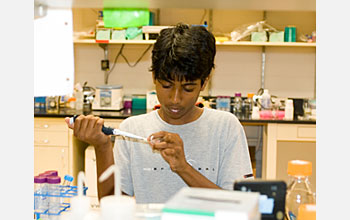

Press Release 08-037
High-School Scientists Decode DNA Sequence, Present Findings

New Jersey students publish their findings, present their work at the National Science Foundation
March 10, 2008
Opportunities for high school students to do research as part of a science class are -- sadly -- all too rare. Where such opportunities do exist, students often find themselves going through the motions of an experiment with a predetermined outcome. Against this backdrop, imagine a project where students can work in a rapidly advancing field, doing original research, then publish their results and share them with the scientific community. About 300 New Jersey high school students have such an opportunity this year through the Waksman Institute at Rutgers University, which operates "HiGene: A Genome Sequencing Project for High Schools." With major funding from the National Science Foundation (NSF) through its Innovative Technology Experiences for Students and Teachers (ITEST) Program, students have been immersing themselves in a research project that draws on the fields of molecular biology and bioinformatics. Five of the students recently presented their findings to an audience of scientists at the National Science Foundation headquarters in Arlington, Va. They described how they worked with bacteria that contained a fragment of a DNA copy of RNA from brine shrimp, purified the fragment and performed a set of analyses to decode a DNA sequence that had never been seen before. They were able to compare their sequence to other DNA sequences and predict the functions of the genes. They then went on to publish their findings through the National Center for Biotechnology Information (NCBI) at the National Institutes of Health. "This approach brings the research to the students in a high school setting" said Drew Vershon, who co-directs the Waksman Institute with William Sofer. (Both are professors in Rutgers' department of molecular biology and biochemistry.) "The immersion in an authentic research project has benefits for both the students and their teachers." The Waksman Institute hosts a Summer Institute where students can begin the DNA sequencing project; but unlike other summer science programs, the teachers of participating students must also attend. At the institute, both teachers and students gain knowledge of molecular biology as well as bioinformatics -- a field that uses techniques such as applied mathematics and computer science to solve biological problems at the molecular level. When the new school year starts, additional students at each high school are recruited to join the project, and students and teachers continue with the research. The project takes different forms at different schools, accounting for the diversity in teachers' and students' backgrounds in different settings. In some cases, the research is done in an academic science class. In other cases, the research takes place in an after-school science club. Students who participate are often eager to pursue other scientific challenges. The program offers advanced modules for students who want to go further with the research. There are also opportunities to bring their work to regional and national science fairs and poster sessions, opportunities that several of these students have taken advantage of. As the program has gone on, several participants have pursued research through work at university science labs. "A number of students, because they've performed this experimentation, have had the confidence to approach university faculty about doing work in their labs," said Drew Vershon. Many graduates of the program have gone on to major in scientific fields in college. Meanwhile, teachers find that the program enriches their teaching. "This experience helps broaden the teachers' perspectives about how science is carried out," said Vershon. "It affects their other teaching in the classroom by making them aware of scientific practices they may not have encountered before. A field like bioinformatics can be brought into other teaching they do." The students' presentation at NSF was greeted with respect and appreciation by scientists from the biosciences and computer sciences, as well as those who work in science education. Julia Clark, program manager for ITEST noted the students' professionalism and enthusiasm for their work. "The students were clearly engaged in the work they'd done and excited about presenting their results," said Clark. "This research project was a fantastic opportunity for them." The students' NSF presentation can be accessed at /news/longurl.cfm?id=41. -NSF-

Media Contacts
Maria C. Zacharias, NSF (703) 292-8070 mzachari@nsf.gov
Program Contacts
Julia V. Clark, NSF (703) 292-5119 jclark@nsf.gov
Principal Investigators
William Sofer, Rutgers University (732) 445-3052 sofer@waksman.rutgers.edu

The National Science Foundation (NSF) is an independent federal agency that supports fundamental research and education across all fields of science and engineering, with an annual budget of $6.06 billion. NSF funds reach all 50 states through grants to over 1,900 universities and institutions. Each year, NSF receives about 45,000 competitive requests for funding, and makes over 11,500 new funding awards. NSF also awards over $400 million in professional and service contracts yearly.
 Get News Updates by Email Get News Updates by Email
Useful NSF Web Sites:
NSF Home Page: http://www.nsf.gov
NSF News: http://www.nsf.gov/news/
For the News Media: http://www.nsf.gov/news/newsroom.jsp
Science and Engineering Statistics: http://www.nsf.gov/statistics/
Awards Searches: http://www.nsf.gov/awardsearch/
|





